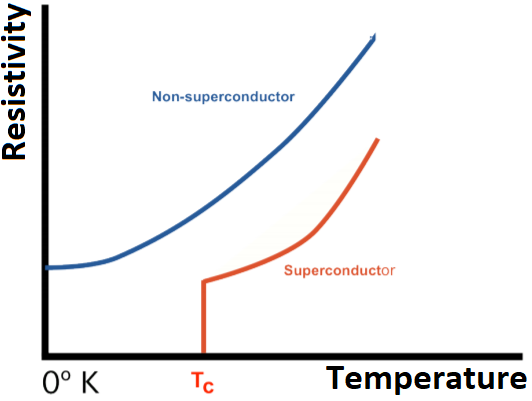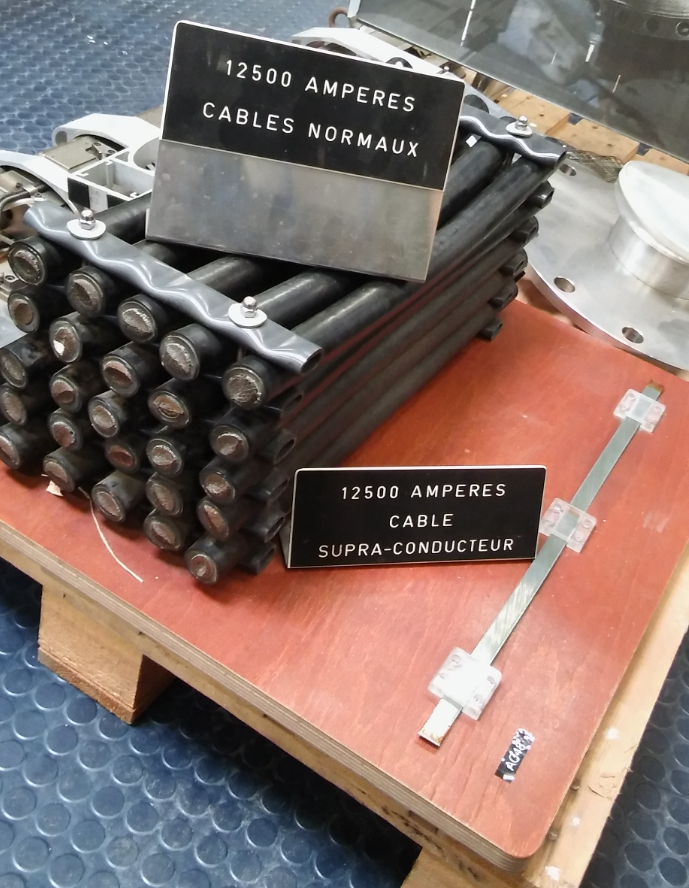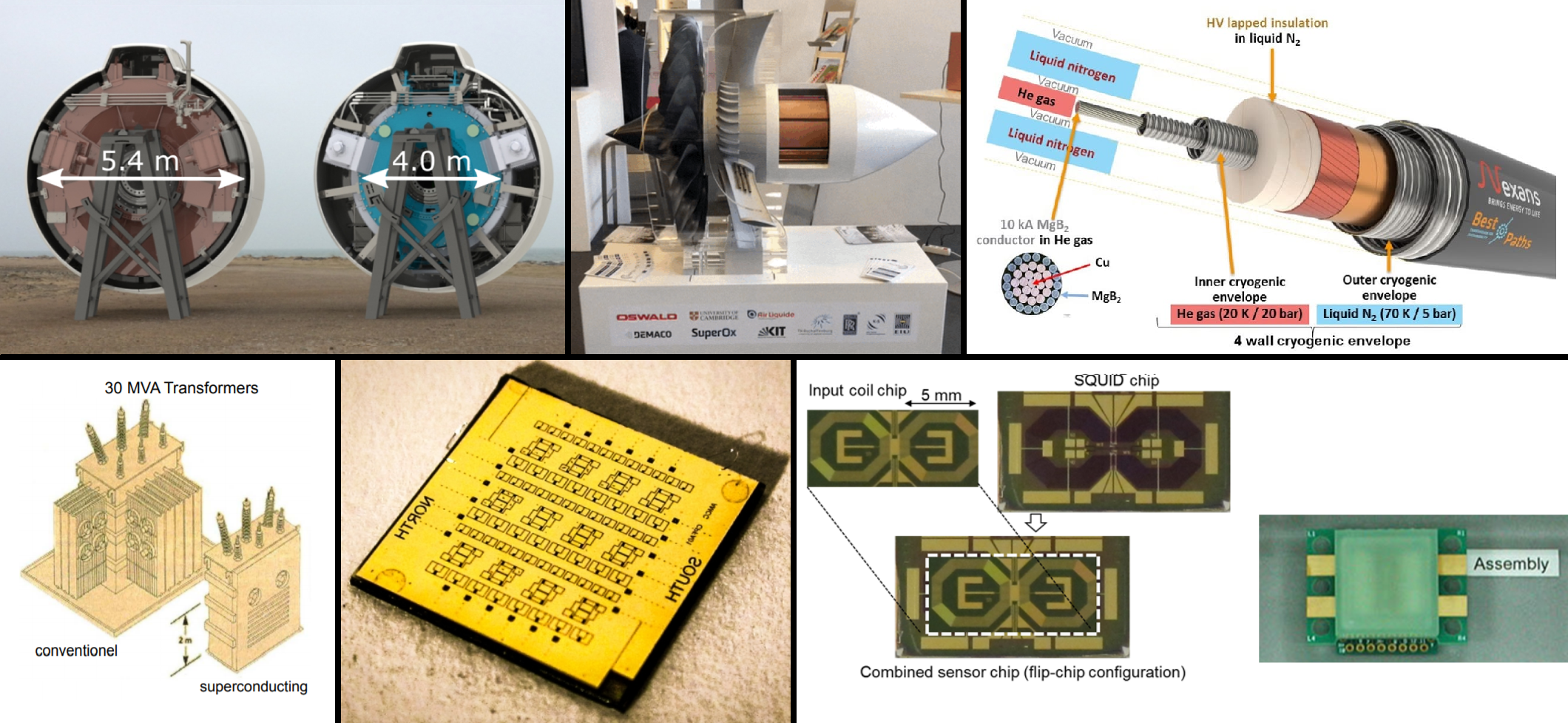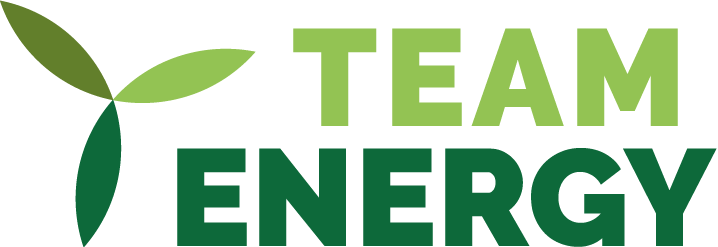The advantages of a superconducting device
An ever-present phenomenon in usual electrical wires is that they exhibit a resistance to the flow of electric current, producing heat, which means that part of the energy is lost in the process. This is why a computer processor, data centers and big transformers in power stations get hot; and why cooling systems have to be used along. Most materials, copper included, follow this behavior, however there are materials that, under certain conditions, won’t exhibit any resistance to the flow of electric current, the so-called superconductors (SC).
Superconductivity can be observed in some materials at very low temperatures. The phenomenon was discovered in 1911 by Heike Kamerlingh Onnes while measuring the resistivity of mercury (Hg) samples cooled down with liquid helium (-269 °C), where it was found that, below a critical temperature, resistivity vanishes in the material, becoming effectively zero [1].

Figure 1: Resistivity in function of the temperature (schematic) [2]
Different superconducting materials have been found through the years since then, and the scientific community is in constant search for materials with a higher critical temperature [3], allowing the use of coolants cheaper than liquid helium, which is a scarce element on earth, with fluctuating prices (∼US$17 at 2016 per liquid liter) and a very limited supply by geographic area, mostly obtained as byproduct during natural gas extraction [4].
The main advantage is that, compared with a cable of the same size made of a regular conductor, a SC cable can conduct a substantially larger electric current without producing heat, eliminating this source of energy losses. Hence, even if them needing a refrigeration system to maintain them in cryogenic temperatures, for high electric current applications (taking into account the power required to run the refrigeration system), SC cables can transmit the same power than an equal current rated copper cable counterpart, in a conductor with a smaller radius [5].

Figure 2: Size comparison between array of copper cables (left) and niobium-titanium superconducting cable (right), both rated to carry 12,500 amperes [6]
Current Technologies
Superconductors have already been used commercially since the early 1960’s in different industries, in materials known as Low Temperature Superconductors (LTS), with critical temperatures below -253 °C, that use liquid helium as coolant. Niobium–titanium (NbTi) and niobium–tin (Nb3Sn) are the most widely used, where applications that require to produce high magnetic fields comprise the biggest portion of their deployment nowadays (by shaping them in a coil), and magnetic fields up to ∼ 20 Tesla can be reached with them [7]. These technologies include:
- Magnetic Resonance Imaging (MRI) Devices that use high magnetic fields for producing images of the interior of the human body without using X-rays, technology broadly distributed in hospitals worldwide [8].
- Nuclear Fusion Devices that produce a magnetically confined plasma that replicate a star (as the sun) energy production process, to eventually develop a new low-carbon energy source. Multiple experiments exist worldwide, mostly as doughnut-shape fusion reactors in the Tokamak or Stellarator configurations [9].
- Particle Accelerator Devices that create beams of fast charged particles, and use magnetic fields to direct them. Examples are the Large Hadron Collider (LHC) at CERN for fundamental particle research, Proton Beam Therapy for cancer treatment, or superconducting radiofrequency (SRF) [10, 11].
- Transportation Fast vehicles such as magnetically levitated trains (maglev) and the Hyperloop concept [12].
- Superconducting Magnetic Energy Storage (SMES), used to store magnetic energy in the form of an electric current running through a SC coil [13].

Figure 3: From left to right: a) MRI scanner, SC coil around the center aperture. b) ITER international nuclear fusion collaboration (toroidal SC coils in orange), first plasma expected by 2025. c) LHC at CERN around the city of Geneva, Switzerland. d) SCmaglev experimental train track, speed of 603km/h achieved, first train line expected by 2027 [14–17].
Emerging Technologies
In 1986, high-temperature superconductivity (HTS) was discovered in cuprates, materials that already become superconducting at around -200 °C. This is the temperature of liquid nitrogen, which is a cheap (price of ∼US$1.50 or even lower at 2018 per liquid liter) and widely available coolant for different industrial cryogenic applications [18], plus, it can be manufactured by liquefying it directly from air (that has 78% of nitrogen), which is not the case for helium.
Rare Earth Barium Copper Oxide materials (ReBCO) are one variety of these cuprates, where the increased supply by different companies in the last ten years has made them more cost effective, and their price has been reduced significantly. However, these materials are brittle (unlike copper cables due to the material ductility), hence making cylindrical cables with them is not straightforward, so the approach is to make planar tapes, which allow for some flexibility. Based on this planar tape shape, different HTS cable designs have been proposed for high electric current applications [19].
HTS can attain significantly stronger magnetic fields than LTS (∼ 100 tesla in some material varieties), improving the capabilities of the applications mentioned previously, plus, the wider temperature window in which they are superconducting allow for a more stable operation, and makes possible to use them in yet more electrical applications. A couple of international projects have been set to accelerate their development and deployment for more energy and industrial applications [20–24]. Additional technologies that can exploit the advantages of HTS include:
- SC Generators Decreased size for the same power output. The Ecoswing project successfully tested a superconducting generator in a wind turbine by April 2019 [25–27].
- SC Motors Higher torque and more compact, for industrial and aviation applications. ASuMED project currently develops a functional prototype [28].
- SC Transformers Higher power rate and smaller size, devices have been succesfully deployed in industry [29, 30].
- SFCL (Superconducting Fault Current Limiter), for overcurrent protection in power grids, devices already operational as a standard technology [31].
- SC Cables For high power transmission. Best-Paths project developed a SC cable design and other technologies, to integrate renewable energies into the grid [32].
- SC Computing Including SC circuits for lower power consumption, as well as quantum computers based on superconductivity principles [33–35].
- Sensors Such as SQUIDS, magnetometers that can measure very small magnetic fields, with applications such as biomagnetism or astronomy [36].

Figure 4: From left to right, up to down: a) For wind turbine, conventional electric generator on left, EcoSwing HTS generator on right, note the smaller diameter of the SC device b) ASuMED display demonstrator c) BestPaths HTS cable design d) Size comparison between conventional and superconducting transformers, rated for the same power output e) nAdder superconducting circuit f) HTS SQUID sensor for use as external pickup coil (left) and packaged SQUID module (right) [37–40]
In a nutshell, the superconducting version of an electrical device will be more energy efficient than the conventional counterpart, producing the same output (power, torque, magnetic field) in a smaller package.
The coming years will show the increasing deployment of these technologies and other applications, who knows, perhaps the finding of the holy grail of superconductivity might be not too far on the horizon: room temperature superconducting (RTS) materials [41], eliminating the need for cryogenic coolants, if at all, perhaps needing only a regular household fridge cooling system.
Written by D. A. Garfias, you can download the article here.
Sources
[1] Dirk van Delft. “History and significance of the discovery of superconductivity by Kamerlingh Onnes in 1911â€. In: Physica C: Superconductivity 479 (2012). Proceedings of VORTEX VII Conference, pp. 30–35. issn: 0921-
4534. doi: https://doi.org/10.1016/j.physc.2012.02.046. url: http://www.sciencedirect.com/ science/article/pii/S0921453412000962.
[2] University of York – Department of Physics. Temperature variation of electrical resistance of a superconductor. https://www.york.ac.uk/media/physics/publicandschools/Temperature%20variation%20of% 20electrical%20resistance%20of%20a%20superconductor%20-%20NEW.pdf. (Accessed on 04/08/2020).
[3] Christian Barth. “High Temperature Superconductor Cable Concepts for Fusion Magnetsâ€. 31.03.04; LK 01. PhD thesis. 2013. 232 pp. isbn: 978-3-7315-0065-0. doi: 10.5445/KSP/1000035747.
[4] David Kramer. “Erratic helium prices create research havocâ€. In: Physics Today 70.1 (2017). url: https: //doi.org/10.1063/PT.3.3424.
[5] R. Radenbaugh. “Refrigeration for Superconductorsâ€. In: Proceedings of the IEEE 92 (Nov. 2004), pp. 1719– 1734. doi: 10.1109/JPROC.2004.833678.
[6] “Niobium Titanium and Copper wire samples. – CERN Document Serverâ€. (Accessed on 04/24/2020). 2009. url: https://cds.cern.ch/record/2253655.
[7] Ren´e Flu¨kiger. “Overview of Superconductivity and Challenges in Applicationsâ€. In: Reviews of Accelerator Science and Technology 05 (Jan. 2012), pp. 1–23. doi: 10.1142/S1793626812300010.
[8] Superconductive magnet design – Questions and Answers in MRI. http://mriquestions.com/superconductivedesign.html. (Accessed on 04/11/2020).
[9] Fusion research worldwide — Max-Planck-Institut fu¨r Plasmaphysik. https://www.ipp.mpg.de/1740642/ weltweit. (Accessed on 04/11/2020).
[10] Science of Proton Therapy: How It Works – NAPT. https://www.proton-therapy.org/science/. (Accessed on 04/10/2020).
[11] Hasan Padamsee. “50 years of success for SRF accelerators—a reviewâ€. In: Superconductor Science and Technology 30.5 (Apr. 2017), p. 053003. doi: 10.1088/1361-6668/aa6376. url: https://doi.org/10.1088% 2F1361-6668%2Faa6376.
[12] Hyperloop — SpaceX. https://www.spacex.com/hyperloop. (Accessed on 04/10/2020).
[13] Md. Abdullah Zaman, Sabbir Ahmed, and Nusrath Monira. “An overview of Superconducting Magnetic Energy Storage (SMES) and Its Applicationsâ€. In: Jan. 2018.
[14] MRI-scan — LUMC. https://www.lumc.nl/patientenzorg/praktisch/patientenfolders/MRI. (Accessed on 04/10/2020).
[15] What is ITER? https://www.iter.org/proj/inafewlines. (Accessed on 04/10/2020).
[16] CMS Experiment at CERN’s LHC. https://cms.cern/news/cms-experiment-cerns-lhc. (Accessed on 04/10/2020).
[17] Japan : the Maglev reaches 603km/hr and a new line of 286 kilometers is building Mediarail.be – Rail Europe
News. https://mediarail.wordpress.com/2018/06/10/japan-the-maglev-reaches-603km-hr-and-anew-line-of-286-kilometers-is-building/. (Accessed on 04/10/2020).
[18] D.G. Schlom and J. Mannhart. “High-temperature Superconductors: Thin Films and Multilayersâ€. In: Encyclopedia of Materials: Science and Technology. Ed. by K.H. Ju¨rgen Buschow et al. Oxford: Elsevier, 2001, pp. 3806–3819. isbn: 978-0-08-043152-9. doi: https://doi.org/10.1016/B0-08-043152-6/00678-1. url: http://www.sciencedirect.com/science/article/pii/B0080431526006781.
[19] W. H. Fietz et al. “High-Current HTS Cables: Status and Actual Developmentâ€. In: IEEE Transactions on Applied Superconductivity 26.4 (June 2016), pp. 1–5. issn: 1051-8223. doi: 10.1109/TASC.2016.2517319.
[20] HTS Components and Devices. http://www.superpower-inc.com/content/hts-components-anddevices. (Accessed on 04/20/2020).
[21] Benjamin Stafford. Can Superconductors Finally Be the Solution to Our Clean Energy Needs? https:// matmatch.com/blog/superconductors-clean-energy/. (Accessed on 04/11/2020).
[22] J. C. Hernandez-Llambes and D. Hazelton. “Advantages of second-generation high temperature superconductors for pulsed power applicationsâ€. In: 2009 IEEE Pulsed Power Conference. June 2009, pp. 221–226. doi: 10.1109/PPC.2009.5386312.
[23] Michael B¨acker. “Energy and superconductors – Applications of high-temperature- superconductorsâ€. In: Zeitschrift fur Kristallographie 226 (Apr. 2011), pp. 343–351. doi: 10.1524/zkri.2011.1330.
[24] Rise of the superconductor – Renewable Energy Focus. http://www.renewableenergyfocus.com/view/ 3224/rise-of-the-superconductor/. (Accessed on 04/11/2020).
[25] Anne Bergen et al. “Design and in-field testing of the world’s first ReBCO rotor for a 3.6 MW wind generatorâ€. In: Superconductor Science and Technology 32.12 (Oct. 2019), p. 125006. doi: 10.1088/1361-6668/ab48d6. url: https://doi.org/10.1088%5C%2F1361-6668%5C%2Fab48d6.
[26] The EcoSwing consortium. Energy Cost Optimization using Superconducting Wind Generators. https:// ecoswing.eu/project. (Accessed on 04/09/2020).
[27] T Winkler and. “The EcoSwing Projectâ€. In: IOP Conference Series: Materials Science and Engineering 502 (Apr. 2019), p. 012004. doi: 10.1088/1757-899x/502/1/012004. url: https://doi.org/10.1088%5C% 2F1757-899x%5C%2F502%5C%2F1%5C%2F012004.
[28] Advanced Superconducting Motor Experimental Demonstrator – H2020. https://cordis.europa.eu/ project/id/723119. (Accessed on 04/10/2020).
[29] M.P. Staines et al. “12 – High-temperature superconducting (HTS) transformers for power grid applicationsâ€. In: Superconductors in the Power Grid. Ed. by Christopher Rey. Woodhead Publishing Series in Energy. Woodhead Publishing, 2015, pp. 367–397. isbn: 978-1-78242-029-3. doi: https://doi.org/10.
1016/B978-1-78242-029-3.00012-1. url: http://www.sciencedirect.com/science/article/pii/ B9781782420293000121.
[30] Mathias Noe. Superconducting Transformers. https://indico.cern.ch/event/626654/attachments/
1523851/2381804/Superconducting_Transformers_-_Dr._Mathias_Noe.pdf. EUCAS Short Course Power Applications (Accessed on 04/10/2020). Sept. 2017.
[31] J. Bock, A. Hobl, and J. Schramm. “Superconducting Fault Current Limiters – a new device for future smart gridsâ€. In: 2012 China International Conference on Electricity Distribution. 2012, pp. 1–4.
[32] Best Paths – New Grid Technologies. http://www.bestpaths-project.eu/en/demonstration. (Accessed on 04/10/2020).
[33] Alex I. Braginski. “Superconductor Electronics: Status and Outlookâ€. In: Journal of Superconductivity and Novel Magnetism 32.1 (2019), pp. 23–44. issn: 1557-1947. doi: 10.1007/s10948-018-4884-4. url: https: //doi.org/10.1007/s10948-018-4884-4.
[34] Larry Hardesty. Superconducting circuits, simplified — MIT News. https://news.mit.edu/2014/cheapersuperconducting-computer-chips-1017. (Accessed on 04/10/2020).
[35] P. Krantz et al. “A quantum engineer’s guide to superconducting qubitsâ€. In: Applied Physics Reviews 6.2 (2019), p. 021318. doi: 10.1063/1.5089550. eprint: https://doi.org/10.1063/1.5089550. url: https:
//doi.org/10.1063/1.5089550.
[36] Navin Khaneja. “SQUID Magnetometers, Josephson Junctions, Confinement and BCS Theory of Superconductivityâ€. In: Mar. 2019. doi: 10.5772/intechopen.83714.
[37] EcoSwing Turbine HTS Drive System. https://ecoswing.eu/images/EcoSwing_Turbine_Tested_HTS_ Drive_System.pdf. (Accessed on 04/11/2020).
[38] A New “Advanced Superconducting Motor Experimental Demonstrator†– Demaco. https://www.demaco.nl/ en/a-new-advanced-superconducting-motor-experimental-demonstrator/. (Accessed on 04/10/2020).
[39] Modular Superconducting Cable Qualified for 10kA Currents with 3.2GW Power Transmission. https:// powerpulse.net/best-paths-superconducting-cable-qualified-for-10ka-currents-with-3-2gwpower-transmission/. (Accessed on 04/11/2020).
[40] International Superconductivity Technology Research Center. HTS Conductor Processinng Power Application Division. http://www.istec.or.jp/device/labo-device-E.html. (Accessed on 04/11/2020).
[41] Anne Marie Helmenstine. In Search of Room-Temperature Superconductors. https://www.thoughtco.com/ room-temperature-superconductors-4159755. (Accessed on 04/10/2020). Feb. 2020.
